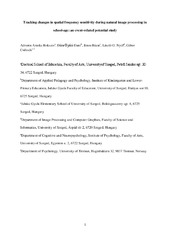Tracking changes in spatial frequency sensitivity during natural image processing in school age: an event-related potential study
Permanent link
https://hdl.handle.net/10037/12866Date
2017-11-09Type
Journal articleTidsskriftartikkel
Peer reviewed
Abstract
Several studies have shown that behavioral and electrophysiological correlates of processing visual images containing low or high spatial frequency (LSF or HSF) information undergo development after early childhood. However, the maturation of spatial frequency sensitivity in school-age has been investigated using abstract stimuli only. The aim of the current study was to assess how LSF and HSF features affect the processing of everyday photographs at the behavioral and electrophysiological levels in children aged 7-15 years and adults. We presented grayscale images containing either animals or vehicles and their luminance-matched modified versions filtered at low or high spatial frequencies. Modulations of classification accuracy, reaction time and visual event-related potentials (posterior P1 and N1 components) were compared across five developmental groups and three image types. We found disproportionately worse response accuracies for LSF stimuli relative to HSF images in children aged 7-8 years, an effect that was accompanied by smaller LSF-evoked P1 amplitudes in this age period. At 7-8 years of age, P1 and N1 amplitudes were modulated by HSF and LSF stimuli (P1: HSF>LSF; N1: LSF>HSF), with a gradual shift towards the opposite pattern (P1: LSF>HSF; N1: HSF>LSF) with increasing age. Our results indicate that early cortical processing of both spatial frequency ranges undergo substantial development in school-age, with a relative delay of LSF analysis, and underline the utility of our paradigm in tracking the maturation of LSF vs. HSF sensitivity in this age group.
Description
Submitted manuscript version. Published version available in Tracking changes in spatial frequency sensitivity during natural image processing in school-age: an event-related potential study (2018) 166, s. 664-678.


 English
English norsk
norsk